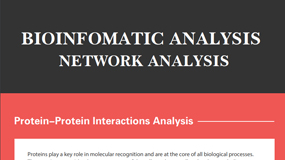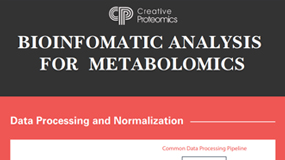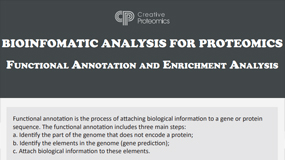Introduction of Bioinformatics
As an interdisciplinary field, bioinformatics combines computer science, statistics and life sciences together, to develop algorithms and professional software tools for mining and interpreting the tremendous biological data, generated in recent booming high throughput -omics studies.
With the development of genomics, transcriptomics, proteomics and metabolomics, the bioinformatics has become more and more important and get even widely application in data mining. To study how the cellular activities are altered in different states, the biological data is combined to form a comprehensive picture, a aerial view of the involved biological activities. As a powerful tool, bioinformatics can help the biologists to increase the understanding of biological processes with computationally intensive techniques, for pattern recognition, data mining, machine learning algorithms, and visualization. And major research efforts in the field include DNA/ RNA/protein sequencing, sequence alignment, gene finding, genome assembly, drug design, drug discovery, protein structure alignment and prediction, prediction of gene expression and protein-protein interactions, genome-wide association studies, and the modeling of evolution.
What Is Mass Spectrometry Data Bioinformatics Analysis
Mass spectrometry data bioinformatics represents an amalgamation of bioinformatics principles and methodologies directed towards deciphering and interpreting the intricate world of mass spectrometry data. Within the realm of life science research, mass spectrometry technology has proliferated in its utilization for profiling the mass-to-charge ratios and charges of proteins, metabolites, and other pivotal biomolecules. This avenue serves as a portal to uncover the intricate landscape of molecular composition and fluctuations resident within biological samples. However, the expansive and intricate datasets arising from mass spectrometry experiments necessitate the judicious application of bioinformatics techniques to navigate and glean insight from their complexity.
The domain of mass spectrometry data bioinformatics spans a spectrum of computational and analytical stratagems. These strategies encompass a repertoire of critical tasks, including initial data preprocessing characterized by peak detection, subsequent peak matching, and the all-important peak quantification. Concurrently, differential analysis emerges as an indispensable tool for the comparative exploration of spectral features among distinct samples. Moreover, the purview of bioinformatics extends to functional annotation, elucidation through pathway analysis, facilitation of protein-protein interaction network elucidation, and beyond. By integrating these multifaceted techniques, researchers embark on a journey toward unearthing intricate molecular relationships and illuminating the underpinnings of biological processes.
Mass Spectrometry Metabolomics And Proteomics Bioinformatics Workflows
 (Yasset Perez-Riverol, Pablo Moreno Proteomics. 2019)
(Yasset Perez-Riverol, Pablo Moreno Proteomics. 2019)
Mass Spectrometry Data Bioinformatics Analysis Content
Data preprocessing and cleaning involves procedures including peak identification, background correction, peak matching, alignment, and mass spectral calibration to guarantee the correctness and quality of the data.
Differential analysis compares spectral properties of various samples and identifies proteins or metabolites that are expressed differently to indicate biological changes.
Combining protein or metabolite data with annotation knowledge from databases to comprehend putative biological activities and pathway enrichment is known as functional annotation and enrichment analysis.
To identify molecules' functions in cellular processes and biological control, pathway analysis maps molecules from mass spectrometry data to biological pathways.
Using information from mass spectrometry, it is possible to anticipate the secondary structures, functional domains, and putative biological roles of proteins.
Network construction is the process of revealing links between proteins by constructing networks of protein-protein interactions based on information about protein interactions obtained from mass spectrometry data.
Identification of possible biomarkers for illness diagnosis or therapy monitoring involves searching through mass spectrometry data for molecules that are differently expressed.
Widespread Applications of Mass Spectrometry Data Bioinformatics
Proteomics: Utilized in complex samples for protein identification, quantification, and functional annotation, proteomics provides details on differences in protein expression, changes, and interactions.
Metabolomics: Analyzing metabolites in samples to comprehend how metabolic pathways are regulated, how metabolites change over time, and how biological processes are modified is known as metabolomics.
Drug Development: Supporting simulation of drug binding sites, prediction of drug-protein interactions, and enhancement of drug design. Disease research identifies prospective biomarkers, explains how diseases work, and offers hints for disease detection and care.
Biological Evolution: Comparing mass spectrometry data from several species to comprehend how protein structure and function have changed over time.
Agricultural science: Investigating crop enhancement and livestock growth through the study of the proteomes and metabolomes of plants and animals.
Advantages of Our Mass Spectrometry Data Bioinformatics Analysis Services
Our proficiency adeptly intertwines the realm of computational science with cutting-edge technologies, encompassing the likes of Shotgun LC-MS/MS, SELDI-TOF MS, MALDI-TOF MS, and protein arrays. This seamless fusion empowers us to unlock invaluable insights encapsulated within the expanse of mass spectrometry data, ushering forth unparalleled revelations for the domain of proteomics and metabolomics data analysis.
Within the realm of Shotgun LC-MS/MS, the panorama of high-resolution mass spectrometry technology unfurls before us, akin to an intricate tapestry of discovery. Herein lies the prowess to unravel the identities and quantities of myriad proteins within intricate samples, unfurling the elaborate choreography of differential expression embedded within biological processes. As the high-resolution spectrum unfolds, we traverse the landscapes of biological complexity, deciphering the nuances of change that lie beneath the surface.
In the domain of SELDI-TOF MS and MALDI-TOF MS, we harness the exquisite dance of mass-to-charge ratios, wherein protein molecules take center stage. Here, the symphony of technology takes on a rapid cadence, enabling the swift identification and meticulous analysis of potential protein biomarkers residing within samples. This orchestration of analytical prowess not only expedites the journey of biomarker discovery but also augments our ability to discern the intricate signatures etched within the data.
Additionally, our arsenal includes the ingenious use of protein array technology – a paradigm where multiple proteins converge in a single experiment, akin to a symphony of molecular interactions. With this prowess, we traverse the landscapes of protein interactions and expressions, uncovering a rich tapestry of interconnected insights within a singular exploration. This technological harmonization encapsulates a realm where interactions unfurl in unison, offering multifaceted insights that illuminate the intricate interactions among proteins.
Equipped with advanced computing instruments and software, our scientists can provide the services as below:
| Bioinformatics for Metabolomics | ||
| Preprocess and normalization | ||
| Univariate analysis | ||
| • Fold change analysis | • T-test analysis | • ANOVA |
| • Correlation analysis | • SAM Service | • Volcano plot |
| Multivariate analysis | ||
| • PCA | • PLS-DA | • OPLS-DA |
| Clustering analysis | ||
| • Heatmap service | • K-means service | • SOM service |
| Classification & feature selection | ||
| Enrichment analysis | ||
| Pathway analysis | ||
| Biomarker analysis | ||
| Association Analysis | ||
Advantages of Our Mass Spectrometry Data Bioinformatics Analysis Services
Proficient Team: Our team comprises seasoned bioinformatics experts and scientists, endowed with extensive knowledge of mass spectrometry technology and biology. This expertise empowers us to provide top-tier analysis and interpretation services.
Cutting-edge Tools: Leveraging advanced computational tools and software, coupled with the latest in mass spectrometry data analysis techniques, guarantees precise and dependable analysis outcomes.
Interdisciplinary Reach: Our services span proteomics and metabolomics, accommodating varied biological data analysis needs across different domains.
Interpretative Insights: Beyond analysis, we contextualize results, enhancing comprehension of the biological nuances embedded in the data.
Tailored Solutions: We offer customized analysis tailored to specific client requisites, accommodating diverse experimental designs and data modalities.
Comprehensive Analysis Scope: Our analysis gamut encompasses data preprocessing, differential analysis, functional annotation, pathway analysis, protein structure prediction, and more, delivering a panoramic data perspective.
Efficient Turnaround: Our commitment to efficiency ensures timely delivery of accurate analysis results, facilitating seamless research advancement.
Customer Support: Our team remains on standby to furnish technical aid and address inquiries, ensuring a thorough grasp of analysis results and methodologies.












